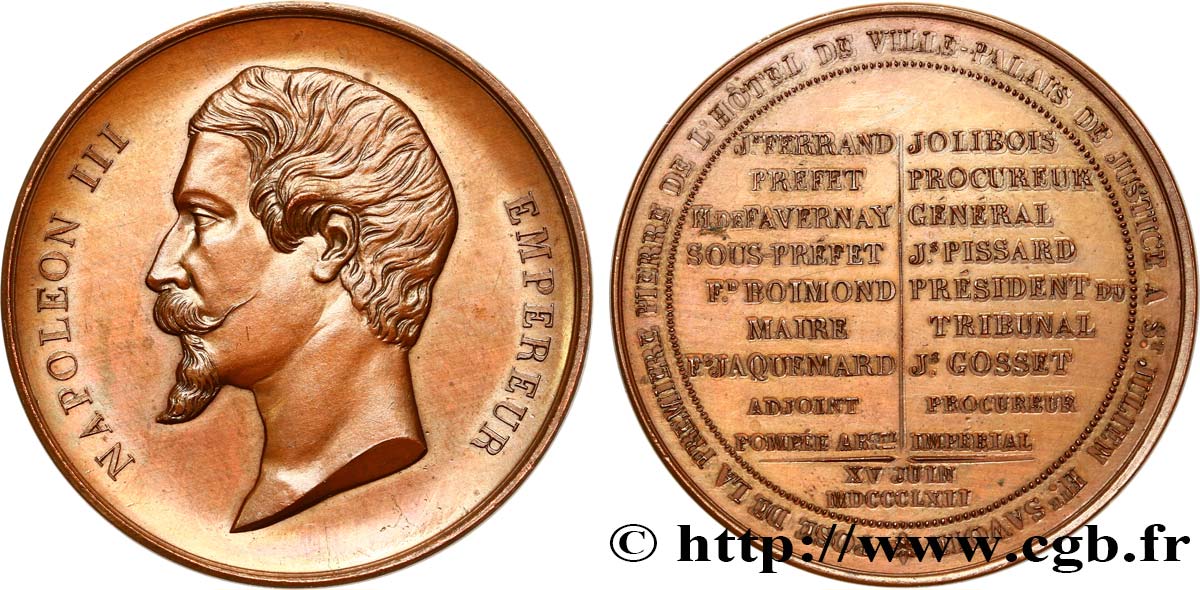fme_494533 - SEGUNDO IMPERIO FRANCES Pose de la première pierre de l’Hôtel de Ville de Saint-Julien
No disponible.
Artículo vendido en nuestra tienda (2019)
Precio : 150.00 €
Artículo vendido en nuestra tienda (2019)
Precio : 150.00 €
Tipo : Pose de la première pierre de l’Hôtel de Ville de Saint-Julien
Fecha: 1862
Nombre del taller / ciudad: 74 - Saint-Julien-en-Genevois
Metal: bronce
Diámetro: 50 mm
Eje de acuñación: 12 h.
Peso: 56 g.
Canto: lisse
Comentarios sobre el estado de conservación:
Patine chocolat. Présence de coups et petites rayures. Tréflage au revers
Anverso
Titulatura del anverso: NAPOLÉON III - EMPEREUR.
Descripción del anverso: Tête nue à gauche de Napoléon III.
Reverso
Titulatura del reverso: POSE DE LA PREMIÈRE PIERRE DE L’HÔTEL DE VILLE - PALAIS DE JUSTICE À ST. JULIEN HTE. SAVOIE // (...).
Descripción del reverso: Légende circulaire et en 20 lignes horizontales sur 2 colonnes.
Comentario
Médaille non signée, pour la pose de la première pierre de l’Hôtel de Ville de Saint-Julien-en-Genevois, le 15 juin 1862.
Saint-Julien en Genevois, ville frontière avec le canton de Genève, se trouve entre Jura et Salève. Elle est au cœur des conflits entre Genève et la Savoie et voit la signature, le 21 juillet 1603, du Traité de Paix qui mit fin aux guerres. Le 5 juillet 1860, la cité passée à la Suisse depuis seulement 45 ans devient française. Deux ans plus tard, elle accueille la Sous-préfecture de la Haute-Savoie. C’est aussi en 1862 qu’est construite la mairie actuelle. Edifier une sous-préfecture dans ce contexte a évidemment un sens symbolique important. La composition classique s’impose par sa rigueur, mais le paradoxe est que l’architecture de l’hôtel de ville est porteuse du style second empire par sa modénature éclectique alors que Pompée reste néo-classique. Sur la base d’un programme voisin une “compétition” architecturale se joue. Le corps central de la sous-préfecture est cantonné par deux pavillons, les encadrements de baies soulignés par des bossages chanfreinés : il se dégage de l’ensemble, une austérité Louis XIII. La mairie propose la disposition inverse avec un pavillon central encadré de deux ailes et des étages soigneusement hiérarchisés. De 1926 à 1964, la sous-préfecture fut rayée de la carte administrative. Le bâtiment accueillit les malades suite à l'incendie de l'hôpital en 1929.
http://www.caue74.fr/m/equipement/administratif/l-hotel-de-ville-et-la-sous-prefecture-de-saint-julien-en-genevois-un-lieu.html.
Unsigned medal, for the laying of the first stone of the Town Hall of Saint-Julien-en-Genevois, June 15, 1862.
Saint-Julien en Genevois, a border town with the canton of Geneva, is located between Jura and Salève. It was at the heart of the conflicts between Geneva and Savoy and saw the signing, on July 21, 1603, of the Peace Treaty which put an end to the wars.. On July 5, 1860, the city, which had been in Switzerland for only 45 years, became French.. Two years later, it welcomed the sub-prefecture of Haute-Savoie. It was also in 1862 that the current town hall was built.. Building a sub-prefecture in this context obviously has an important symbolic meaning.. The classical composition is imposed by its rigor, but the paradox is that the architecture of the town hall is the bearer of the Second Empire style by its eclectic modenature while Pompey remains neo-classical. Based on a similar program, an architectural “competition” is taking place. The central body of the sub-prefecture is flanked by two pavilions, the bay frames highlighted by chamfered bosses: the whole exudes a Louis XIII austerity.. The town hall proposes the opposite layout with a central pavilion framed by two wings and carefully hierarchical floors.. From 1926 to 1964, the sub-prefecture was removed from the administrative map. The building housed the sick following the hospital fire in 1929.
http://www. caue74. fr/m/equipment/administrative/the-town-hall-and-the-sub-prefecture-of-saint-julien-en-genevois-a-place. html
Saint-Julien en Genevois, ville frontière avec le canton de Genève, se trouve entre Jura et Salève. Elle est au cœur des conflits entre Genève et la Savoie et voit la signature, le 21 juillet 1603, du Traité de Paix qui mit fin aux guerres. Le 5 juillet 1860, la cité passée à la Suisse depuis seulement 45 ans devient française. Deux ans plus tard, elle accueille la Sous-préfecture de la Haute-Savoie. C’est aussi en 1862 qu’est construite la mairie actuelle. Edifier une sous-préfecture dans ce contexte a évidemment un sens symbolique important. La composition classique s’impose par sa rigueur, mais le paradoxe est que l’architecture de l’hôtel de ville est porteuse du style second empire par sa modénature éclectique alors que Pompée reste néo-classique. Sur la base d’un programme voisin une “compétition” architecturale se joue. Le corps central de la sous-préfecture est cantonné par deux pavillons, les encadrements de baies soulignés par des bossages chanfreinés : il se dégage de l’ensemble, une austérité Louis XIII. La mairie propose la disposition inverse avec un pavillon central encadré de deux ailes et des étages soigneusement hiérarchisés. De 1926 à 1964, la sous-préfecture fut rayée de la carte administrative. Le bâtiment accueillit les malades suite à l'incendie de l'hôpital en 1929.
http://www.caue74.fr/m/equipement/administratif/l-hotel-de-ville-et-la-sous-prefecture-de-saint-julien-en-genevois-un-lieu.html.
Unsigned medal, for the laying of the first stone of the Town Hall of Saint-Julien-en-Genevois, June 15, 1862.
Saint-Julien en Genevois, a border town with the canton of Geneva, is located between Jura and Salève. It was at the heart of the conflicts between Geneva and Savoy and saw the signing, on July 21, 1603, of the Peace Treaty which put an end to the wars.. On July 5, 1860, the city, which had been in Switzerland for only 45 years, became French.. Two years later, it welcomed the sub-prefecture of Haute-Savoie. It was also in 1862 that the current town hall was built.. Building a sub-prefecture in this context obviously has an important symbolic meaning.. The classical composition is imposed by its rigor, but the paradox is that the architecture of the town hall is the bearer of the Second Empire style by its eclectic modenature while Pompey remains neo-classical. Based on a similar program, an architectural “competition” is taking place. The central body of the sub-prefecture is flanked by two pavilions, the bay frames highlighted by chamfered bosses: the whole exudes a Louis XIII austerity.. The town hall proposes the opposite layout with a central pavilion framed by two wings and carefully hierarchical floors.. From 1926 to 1964, the sub-prefecture was removed from the administrative map. The building housed the sick following the hospital fire in 1929.
http://www. caue74. fr/m/equipment/administrative/the-town-hall-and-the-sub-prefecture-of-saint-julien-en-genevois-a-place. html








 Informar de un error
Informar de un error Imprimir la página
Imprimir la página Comparte mi selección
Comparte mi selección Haz una pregunta
Haz una pregunta Consignar / vender
Consignar / vender
 Descriptivo
Descriptivo









